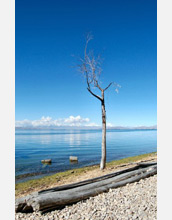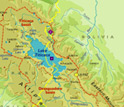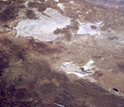News Release 10-216
Catastrophic Drought Looms for Capital City of Bolivia
Historical ecology of the Andes indicates desert-like setting on the horizon

Drought is on the horizon for the region surrounding Lake Titicaca; it may arrive by 2040.
November 12, 2010
This material is available primarily for archival purposes. Telephone numbers or other contact information may be out of date; please see current contact information at media contacts.
Catastrophic drought is on the near-term horizon for the capital city of Bolivia, according to new research into the historical ecology of the Andes.
If temperatures rise more than 1.5 to 2 degrees Celsius (3 to 5 degrees Fahrenheit) above those of modern times, parts of Peru and Bolivia will become a desert-like setting.
The change would be disastrous for the water supply and agricultural capacity of the two million inhabitants of La Paz, Bolivia's capital city, scientists say.
The results, derived from research funded by the National Science Foundation (NSF) and conducted by scientists affiliated with the Florida Institute of Technology (FIT), appear in the November issue of the journal Global Change Biology.
Climatologist Mark Bush of FIT led a research team investigating a 370,000-year record of climate and vegetation change in Andean ecosystems.
The scientists used fossilized pollen trapped in the sediments of Lake Titicaca, which sits on the border of Peru and Bolivia.
They found that during two of the last three interglacial periods, which occurred between 130,000-115,0000 years ago and 330,000-320,000 years ago, Lake Titicaca shrank by as much as 85 percent.
Adjacent shrubby grasslands were replaced by desert.
In each case, a steady warming occurred that caused trees to migrate upslope, just as they are doing today.
However, as the climate kept warming, the system suddenly flipped from woodland to desert.
"The evidence is clear that there was a sudden change to a much drier state," said Bush.
Scientist Sherilyn Fritz at the University of Nebraska-Lincoln showed that during these warm episodes the algae living in Lake Titicaca shifted from freshwater species to ones tolerant of salty water. Paul Baker of Duke University identified peaks of carbonate deposition.
Both point to a sudden shallowing of the lake due to evaporative loss.
An environmental reconstruction demonstrates that with moderate warming, forests moved upslope. But as that warming continued, a climate tipping point was reached.
The system was thrown into a new, drier state that halted forest expansion.
The tipping point is caused by increased evaporative loss from Lake Titicaca.
As the lake contracts, the local climate effects attributable to a large lake--doubling of rainfall, among the most important--would be lost, says Bush.
Such tipping points have been postulated by other studies, but this work allowed the researchers to state when the system will change.
Based on the growth limits of Andean forests, they defined a tipping point that was exceeded within a 1.5 to 2 degrees Celsius warming above modern conditions.
Given a rate of warming in the Peruvian Andes of about 0.3-0.5 degrees Celsius per decade, the tipping point ahead would be reached between 2040 and 2050.
"The implications would be profound for some two million people," says Paul Filmer, program director in NSF's Division of Earth Sciences. Severe drought, and a loss of stored water in lakes in the region, would reduce yields from important agricultural regions and threaten drinking water supplies.
The research suggests that limiting wildfires would help delay the worst effects of the drought.
-NSF-
-
Lake Titicaca, and parts of Peru and Bolivia, are on the cusp of a major drought.
Credit and Larger Version -
This woodland near the lake is similar to those of past times with temperatures like today's.
Credit and Larger Version -
Saltbush pollen, the most common type of pollen during times of near-desert conditions.
Credit and Larger Version -
Lake Titicaca from space. Its outline may look very different in the future.
Credit and Larger Version -
Foreshadowing: in many years, nearby Lake Poopo has dried up but for brief periods.
Credit and Larger Version
Media Contacts
Cheryl Dybas, NSF, (703) 292-7734, email: cdybas@nsf.gov
The U.S. National Science Foundation propels the nation forward by advancing fundamental research in all fields of science and engineering. NSF supports research and people by providing facilities, instruments and funding to support their ingenuity and sustain the U.S. as a global leader in research and innovation. With a fiscal year 2023 budget of $9.5 billion, NSF funds reach all 50 states through grants to nearly 2,000 colleges, universities and institutions. Each year, NSF receives more than 40,000 competitive proposals and makes about 11,000 new awards. Those awards include support for cooperative research with industry, Arctic and Antarctic research and operations, and U.S. participation in international scientific efforts.
Connect with us online
NSF website: nsf.gov
NSF News: nsf.gov/news
For News Media: nsf.gov/news/newsroom
Statistics: nsf.gov/statistics/
Awards database: nsf.gov/awardsearch/
Follow us on social
Twitter: twitter.com/NSF
Facebook: facebook.com/US.NSF
Instagram: instagram.com/nsfgov







